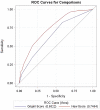Validation of a Post-Transplant Lymphoproliferative Disorder Risk Prediction Score and Derivation of a New Prediction Score Using a National Bone Marrow Transplant Registry Database
- PMID: 34506688
- PMCID: PMC8571765
- DOI: 10.1002/onco.13969
Validation of a Post-Transplant Lymphoproliferative Disorder Risk Prediction Score and Derivation of a New Prediction Score Using a National Bone Marrow Transplant Registry Database
Abstract
Background: We externally validated Fujimoto's post-transplant lymphoproliferative disorder (PTLD) scoring system for risk prediction by using the Taiwan Blood and Marrow Transplant Registry Database (TBMTRD) and aimed to create a superior scoring system using machine learning methods.
Materials and methods: Consecutive allogeneic hematopoietic cell transplant (HCT) recipients registered in the TBMTRD from 2009 to 2018 were included in this study. The Fujimoto PTLD score was calculated for each patient. The machine learning algorithm, least absolute shrinkage and selection operator (LASSO), was used to construct a new score system, which was validated using the fivefold cross-validation method.
Results: We identified 2,148 allogeneic HCT recipients, of which 57 (2.65%) developed PTLD in the TBMTRD. In this population, the probabilities for PTLD development by Fujimoto score at 5 years for patients in the low-, intermediate-, high-, and very-high-risk groups were 1.15%, 3.06%, 4.09%, and 8.97%, respectively. The score model had acceptable discrimination with a C-statistic of 0.65 and a near-perfect moderate calibration curve (HL test p = .81). Using LASSO regression analysis, a four-risk group model was constructed, and the new model showed better discrimination in the validation cohort when compared with The Fujimoto PTLD score (C-statistic: 0.75 vs. 0.65).
Conclusion: Our study demonstrated a more comprehensive model when compared with Fujimoto's PTLD scoring system, which included additional predictors identified through machine learning that may have enhanced discrimination. The widespread use of this promising tool for risk stratification of patients receiving HCT allows identification of high-risk patients that may benefit from preemptive treatment for PTLD.
Implications for practice: This study validated the Fujimoto score for the prediction of post-transplant lymphoproliferative disorder (PTLD) development following hematopoietic cell transplant (HCT) in an external, independent, and nationally representative population. This study also developed a more comprehensive model with enhanced discrimination for better risk stratification of patients receiving HCT, potentially changing clinical managements in certain risk groups. Previously unreported risk factors associated with the development of PTLD after HCT were identified using the machine learning algorithm, least absolute shrinkage and selection operator, including pre-HCT medical history of mechanical ventilation and the chemotherapy agents used in conditioning regimen.
Keywords: Hematopoietic cell transplant; Least absolute shrinkage and selection operator; Post-transplant lymphoproliferative disorder; Predictive scoring system.
© 2021 AlphaMed Press.
Conflict of interest statement
Figures



Similar articles
-
Dynamics of Epstein-Barr virus on post-transplant lymphoproliferative disorders after antithymocyte globulin-conditioned allogeneic hematopoietic cell transplant.Transpl Infect Dis. 2021 Oct;23(5):e13719. doi: 10.1111/tid.13719. Epub 2021 Sep 12. Transpl Infect Dis. 2021. PMID: 34453768
-
Risk Factors and Predictive Scoring System For Post-Transplant Lymphoproliferative Disorder after Hematopoietic Stem Cell Transplantation.Biol Blood Marrow Transplant. 2019 Jul;25(7):1441-1449. doi: 10.1016/j.bbmt.2019.02.016. Epub 2019 Feb 20. Biol Blood Marrow Transplant. 2019. PMID: 30794929 Clinical Trial.
-
Retrospective database analysis of healthcare resource utilization and costs in patients who develop post-transplant lymphoproliferative disease within the first year following allogeneic hematopoietic stem cell transplants.J Med Econ. 2020 Oct;23(10):1159-1167. doi: 10.1080/13696998.2020.1793765. Epub 2020 Jul 22. J Med Econ. 2020. PMID: 32643493
-
Epstein-Barr virus related post-transplant lymphoproliferative disorder prevention strategies in allogeneic hematopoietic stem cell transplantation.Rev Med Virol. 2020 Jul;30(4):e2108. doi: 10.1002/rmv.2108. Epub 2020 Apr 17. Rev Med Virol. 2020. PMID: 32301566 Review.
-
Epstein-Barr virus-associated post-transplantation lymphoproliferative disorder: potential treatments and implications for nursing practice.Clin J Oncol Nurs. 2015 Feb;19(1):94-8. doi: 10.1188/15.CJON.94-98. Clin J Oncol Nurs. 2015. PMID: 25689655 Review.
Cited by
-
Bridging Real-World Data Gaps: Connecting Dots Across 10 Asian Countries.JMIR Med Inform. 2024 Aug 15;12:e58548. doi: 10.2196/58548. JMIR Med Inform. 2024. PMID: 39026427 Free PMC article.
-
Recent advancements in hematopoietic stem cell transplantation in Taiwan.Tzu Chi Med J. 2024 Mar 26;36(2):127-135. doi: 10.4103/tcmj.tcmj_276_23. eCollection 2024 Apr-Jun. Tzu Chi Med J. 2024. PMID: 38645784 Free PMC article. Review.
-
Important Considerations in the Diagnosis and Management of Post-transplant Lymphoproliferative Disorder.Curr Oncol Rep. 2023 Aug;25(8):883-895. doi: 10.1007/s11912-023-01418-0. Epub 2023 May 10. Curr Oncol Rep. 2023. PMID: 37162742 Free PMC article. Review.
-
The Applications of Machine Learning in the Management of Patients Undergoing Stem Cell Transplantation: Are We Ready?Cancers (Basel). 2025 Jan 25;17(3):395. doi: 10.3390/cancers17030395. Cancers (Basel). 2025. PMID: 39941764 Free PMC article. Review.
-
The Health Impact of Using Anti-PD-1 Agents to Treat Early-Stage Cancer in Belgium.Oncol Ther. 2025 Sep;13(3):735-753. doi: 10.1007/s40487-025-00357-z. Epub 2025 Jul 24. Oncol Ther. 2025. PMID: 40707860
References
-
- Shapiro RS, McClain K, Frizzera G et al. Epstein‐Barr virus associated B cell lymphoproliferative disorders following bone marrow transplantation. Blood 1988;71:1234–1243. - PubMed
-
- Zutter MM, Martin PJ, Sale GE et al. Epstein‐Barr virus lymphoproliferation after bone marrow transplantation. Blood 1988;72:520–529. - PubMed
-
- Nalesnik MA. Clinical and pathological features of post‐transplant lymphoproliferative disorders (PTLD). Springer Semin Immunopathol 1998;20:325–342. - PubMed
Publication types
MeSH terms
LinkOut - more resources
Full Text Sources

